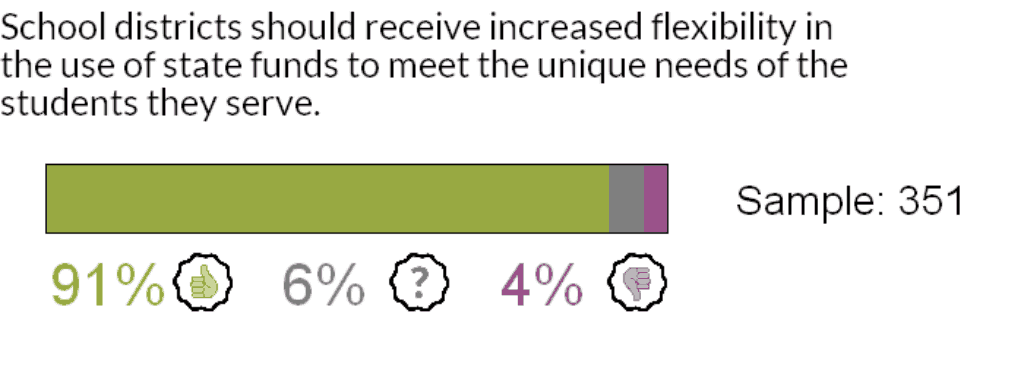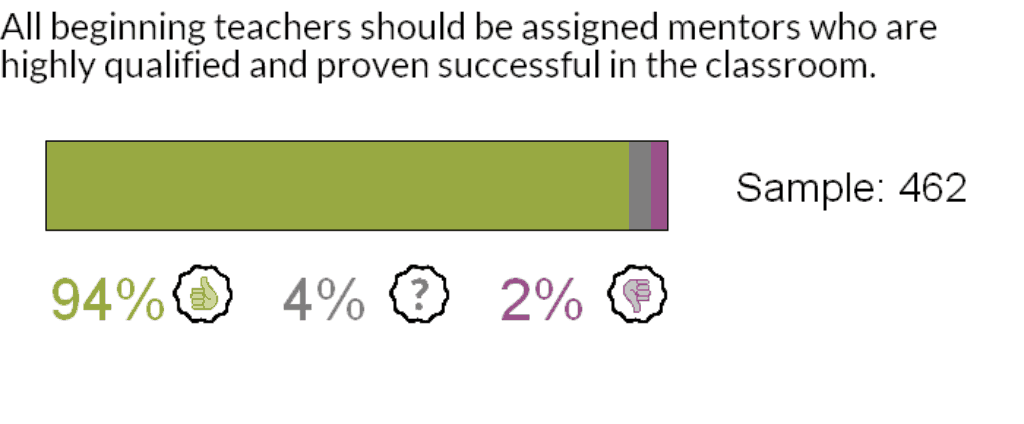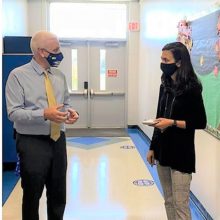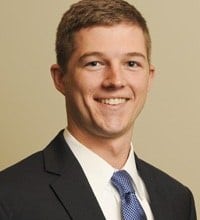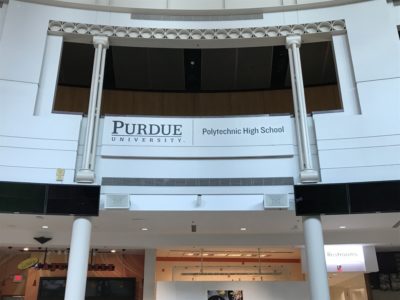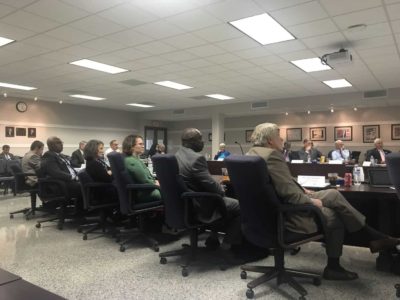In February 2019, Reach NC Voices invited North Carolinians to participate in an online project called the People’s Session. The goal was to present a mechanism by which North Carolinians could share their thoughts on a number of education issues likely to arise this legislative session.
To do this, we used an online survey powered by Consensus, a community collaboration tool for finding common ground. Consensus gathers a diverse set of viewpoints and tasks the community with evaluating them to identify which views enjoy broad agreement (consensus), and which views may be divisive or unclear. By crowd-sourcing community viewpoints and evaluation, Consensus enables us to identify the priorities and opinions of the community.
Here’s how it worked: Participants had the ability to weigh in on a set of policy statements that reflected potential issues and policies that could arise this legislative session. After selecting agree, disagree, or unsure on a minimum of 10 statements, participants could submit their own statements to the project. As project moderators, we reviewed all submitted comments and added some of them to the People’s Session, allowing participants to weigh in on those as well.
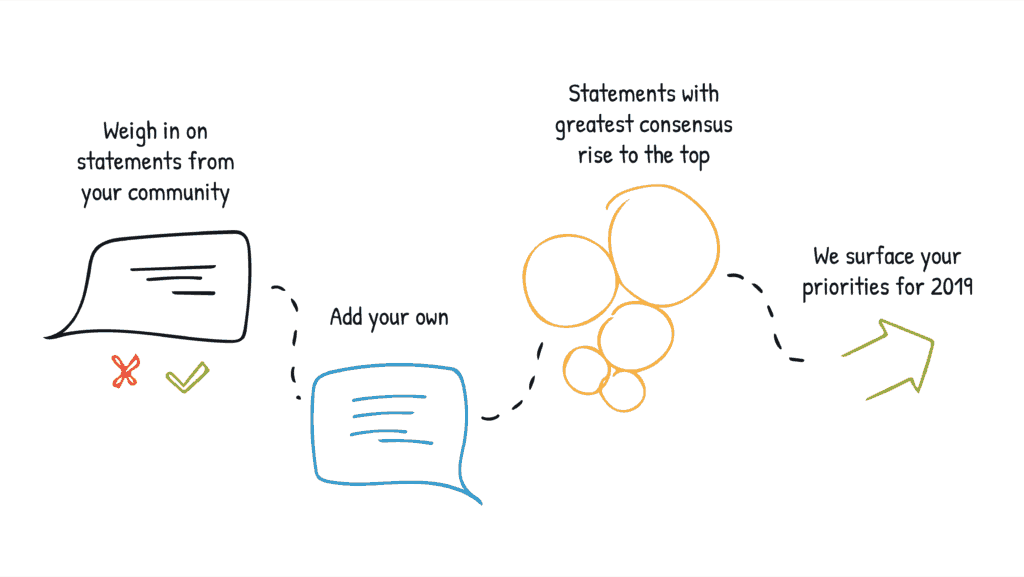
At the bottom of this article, you’ll find more information on how the People’s Session worked and who participated.
Top 5 statements: Most consensus
After removing “unsure” responses and statements with less than 100 responses from the sample, the following five statements had the most consensus (closest to total agreement or total disagreement).
This user-submitted statement pertains to funding flexibility for North Carolina public school districts. Currently, the state doles out funds using a series of allotments — 37 in total. The allotments are essentially line items designating a specific amount for classroom teachers, an amount for school building administration, etc. This is called the resource allocation model. For more on this, read our piece from 2018 on education leaders making a case for increased flexibility.
Such flexibility is currently offered through the Restart program. The Restart program gives some of the state’s lowest-performing public schools more flexibility to make changes in the hopes of improving student performance. The relaxed regulations permit schools to extend the school day, use funds in ways not designated by the state, hire teachers for positions other than those for which they are licensed, and more. For more on this, read the following resources.
- How will charter-like flexibility change North Carolina education?
- Restart program gives some low-performing schools flexibility to help struggling students
- After years of struggles, more than 100 NC schools hope new program will lead to success
- Is this flexible program for struggling schools the future of NC public education?
- Starting Restart in North Carolina’s traditional public schools
Following the school shooting in Parkland, the House Select Committee on School Safety was created to study and recommend ways to make the state’s schools and students safer. Last week, House Speaker Tim Moore, R-Cleveland, reauthorized the committee for this legislative session.
In one meeting of the committee, focus was given to the role of school support staff in creating a healthy and safe school environment. Currently, North Carolina’s ratios for school nurses, school psychologists, school counselors, and school social workers fall above national recommended ratios.
For more on school safety legislation, read the following resources, which are in chronological order for clarity.
- Subcommittee on student health: More school psychologists needed to keep schools safe: During an April 2018 meeting of the House Select Committee on School Safety, legislators heard about the impacts of severely limited school support staff.
- Governor’s Leandro commission looks at North Carolina’s school support personnel: In January, the Governor’s Commission on Access to Sound Basic Education heard about barriers facing school support staff in their work to ensure the physical, social, and behavioral health and wellbeing of students.
- House education committee passes school safety measures: In February, a bill with recommendations from the House Select Committee on School Safety — including threat assessment teams for each school and school resource officer training — moved successfully through the House K-12 education committee.
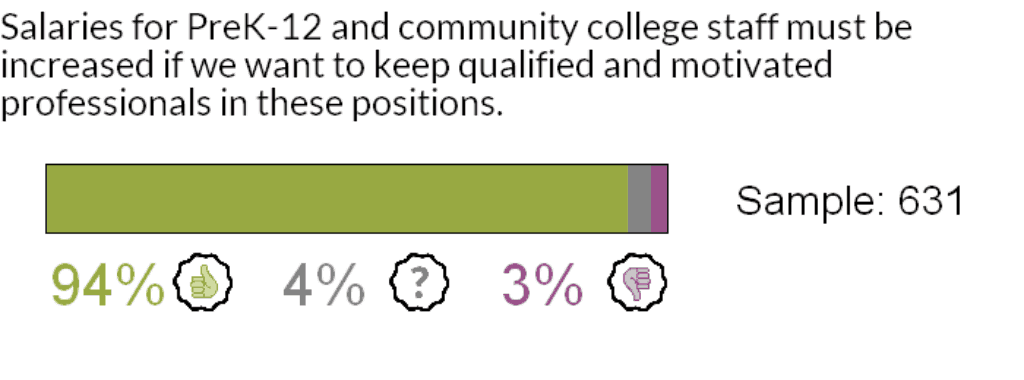
This user-submitted statement reflects a priority that came up time and time again from participants in the People’s Session: increasing educator pay for everyone from kindergarten teachers to community college faculty. Roughly 32 statements of the user-submitted statements in the People’s Session referenced teacher pay or community college adjunct/faculty pay in some regard.
This user-submitted statement was one of many that referenced support for teachers in the classroom. While this statement specifically talks about mentors, other statements referenced the need for high-quality, compensated professional development and advanced teaching roles.
Results from the 2018 North Carolina Teacher Working Conditions survey include responses from almost 15,000 beginning teachers across the state. Of the beginning teachers who responded, 94 percent said they were formally assigned a mentor, and 54 percent said they are given formal time to meet with their mentor during school hours. For a look at the beginning teacher support program standards outlined by the North Carolina Department of Instruction, click here.

This user-submitted statement encompasses a theme that came up repeatedly during the People’s Session: adequate state-level funding for schools, including things like classroom supplies and materials. For a closer look at the specific issue of school supplies funding, read this piece from 2017.
Top five statements: Most divisive
After removing “unsure” responses and statements with less than 100 responses from the sample, the following five statements were the most divisive (farthest from total agreement or total disagreement).

This user-submitted statement on free community college tuition does not reflect a policy being currently considered in North Carolina. However, in Tennessee, free community college tuition is offered through the Tennessee Promise. The program offers last-dollar scholarships to eligible seniors, who can use the scholarships at any of the state’s 13 community colleges, 27 colleges of applied technology, and other eligible institutions offering an associate degree program.
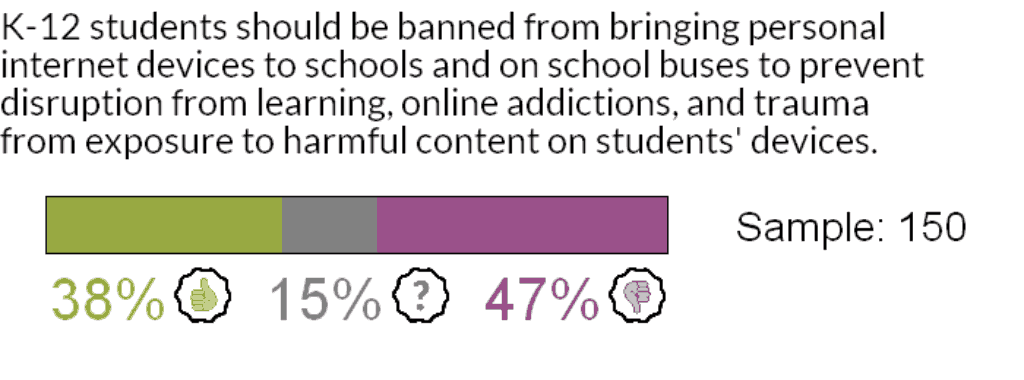
This statement, like a few others submitted to the People’s Session, reflects concern over the use of personal technology devices by students during the school day. As districts and schools further integrate technology into the classroom, both on student-provided and school-provided devices, the role of that technology will continue to face debate.

In addition to three statements originally included in the People’s Session, eight user-submitted statements referenced school performance grades. This statement asserts that school performance grades should consist of 80 percent student growth and 20 percent student achievement — the inverse of the way in which grades are currently calculated. For more on school performance grades, see the following resources.
- EdExplainer: How schools are graded and why it matters: Read this piece for a primer on how school performance grades work. Note: This article is from 2017 and does not reflect current legislation on the issue.
- Mapping the 2017-18 school report cards: This interactive map lets you adjust school performance grades based on different levels of achievement vs. growth, point scales, and a variety of other factors.
- House education committee tackles school performance grades: This article recaps recent legislation heard by the House K-12 committee concerning school performance grades.
 The most-voted on statement in the People’s Session was also one of the most divisive. This statement reflects the general premise of a school construction bill introduced in January by Senate Republicans. Senate Bill 5, Building North Carolina’s Future, would increase state revenue funds that go into the State Capital and Infrastructure Fund (SCIF) from 4 to 4.5 percent to raise more than $2 billion over nine years for K-12 school construction and maintenance. Senate Bill 5 was created in response to the infrastructure bond bill House Speaker Tim Moore, R-Cleveland, filed at the end of last year. For more on school construction legislation, see the following resources.
The most-voted on statement in the People’s Session was also one of the most divisive. This statement reflects the general premise of a school construction bill introduced in January by Senate Republicans. Senate Bill 5, Building North Carolina’s Future, would increase state revenue funds that go into the State Capital and Infrastructure Fund (SCIF) from 4 to 4.5 percent to raise more than $2 billion over nine years for K-12 school construction and maintenance. Senate Bill 5 was created in response to the infrastructure bond bill House Speaker Tim Moore, R-Cleveland, filed at the end of last year. For more on school construction legislation, see the following resources.
- Senators strike back against House building bond proposal: This piece summarizes a press conference that first announced Senate Bill 5 in January.
- Senate school construction plan clears first hurdle: In February, Senate Bill 5 cleared the chamber’s appropriations committee meeting.
- State politicians spar over construction bills as Senate proposal moves closer to hearing: In late February, the Senate rules and operations committee gave a favorable report to Senate Bill 5.
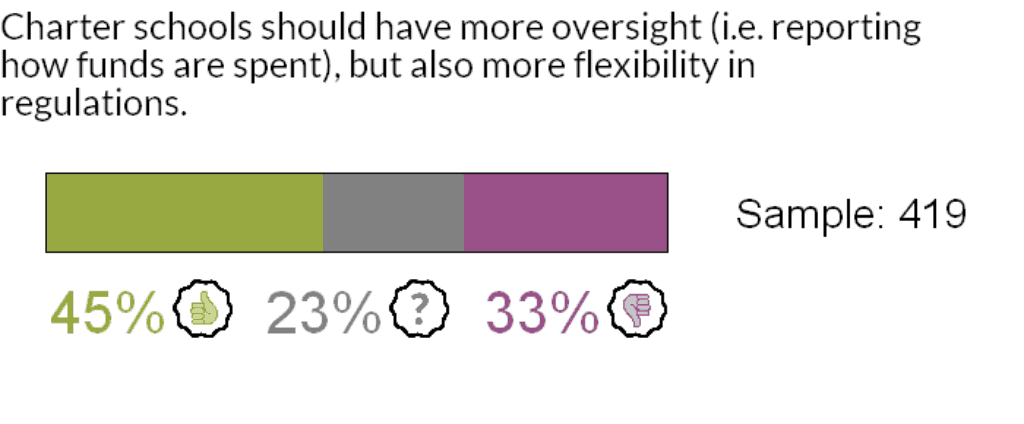
This user-submitted statement was one of 11 statements related to charter schools that ended up in the People’s Session. Charter schools are public schools that are publicly funded but privately operated. Individuals, groups, and both for-profit and non-profit organizations can apply to open and operate a charter school in North Carolina.
Charter schools are granted freedom from many of the rules and regulations imposed on traditional public schools. Different states have different laws governing charters, but largely charters have flexibility in how they spend their budget, who they hire and how they staff the school, what curriculum they use, and how long the school day and school year should be, among other things. In North Carolina, only 50 percent of teachers at a charter school are required to be licensed.
For more on charter schools in North Carolina, see the following resources.
- Charter schools in North Carolina: An overview: This piece explains how charter schools in North Carolina operate and looks at relevant data and research surrounding their impact.
- Senate Bill 247 sponsors talk about accountability and transparency for charters: Following his filing of a bill aimed at studying and, at least temporarily, capping the number of public charter schools, Senate minority leader Dan Blue, D-Wake, formally introduced his legislation and spoke about accountability and transparency last week.
How did it work?
The People’s Session was hosted on EdNC.org and was accessible via any internet-enabled device, including mobile phones.
To begin, participants had a chance to weigh in on a set of 35 policy statements originally included in the project. Those statements reflected potential education policy issues that could arise during the 2019 legislative session and were sourced from interviews that EdNC reporter Alex Granados completed with stakeholders across North Carolina. For participants, the voting process looked like this.
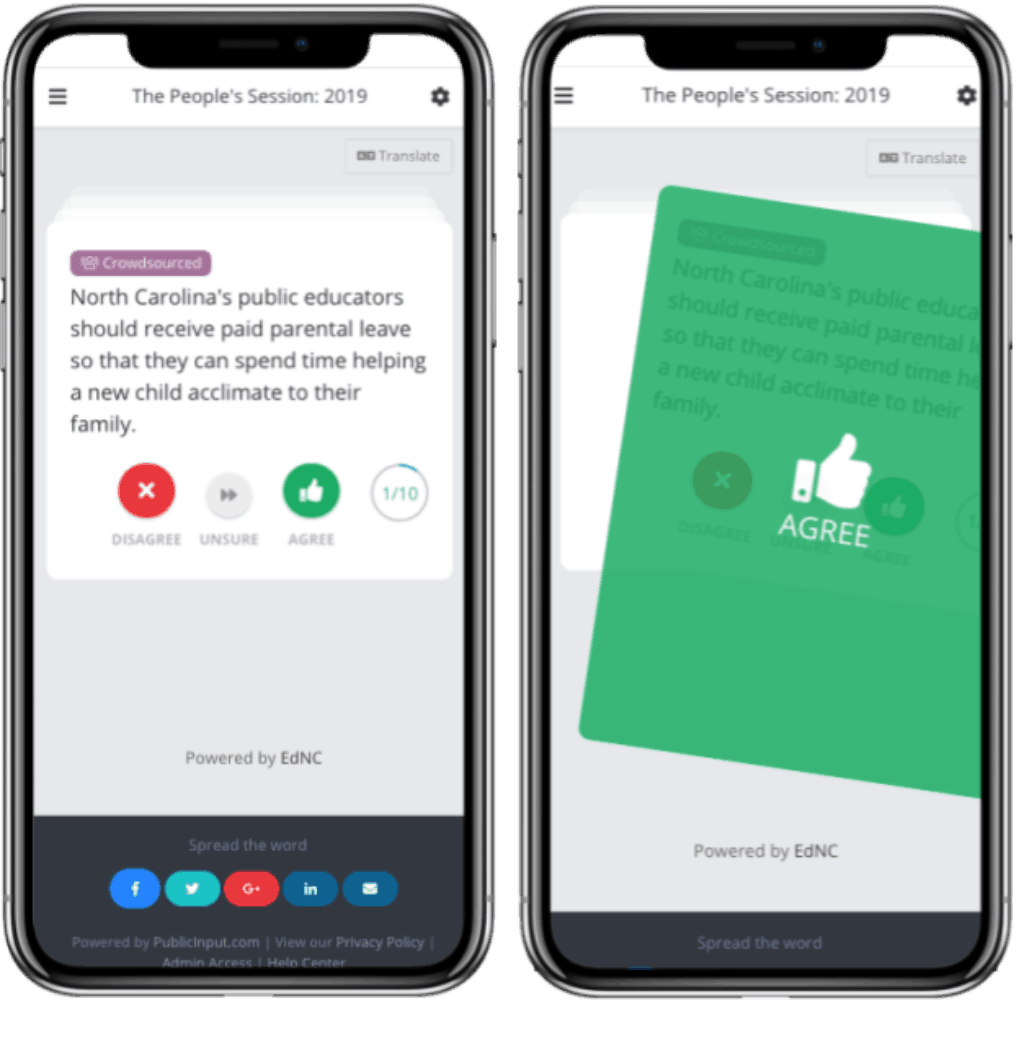
Participants could select agree, disagree, or unsure. Then, they received the next statement.
After responding to at least 10 statements, participants unlocked the ability to share their own policy priorities by responding to the question: “What do you think the legislature should accomplish this session?”
Then, their statements were submitted for consideration by our team. If approved, their statement was added to the deck of statements for other participants to weigh in on. A purple “Crowdsourced” button appeared above all user-submitted statements.
As crowdsourced statements were added to the project, our team worked to re-order the deck randomly each day to ensure that every statement had an equal chance at being viewed by a participant.
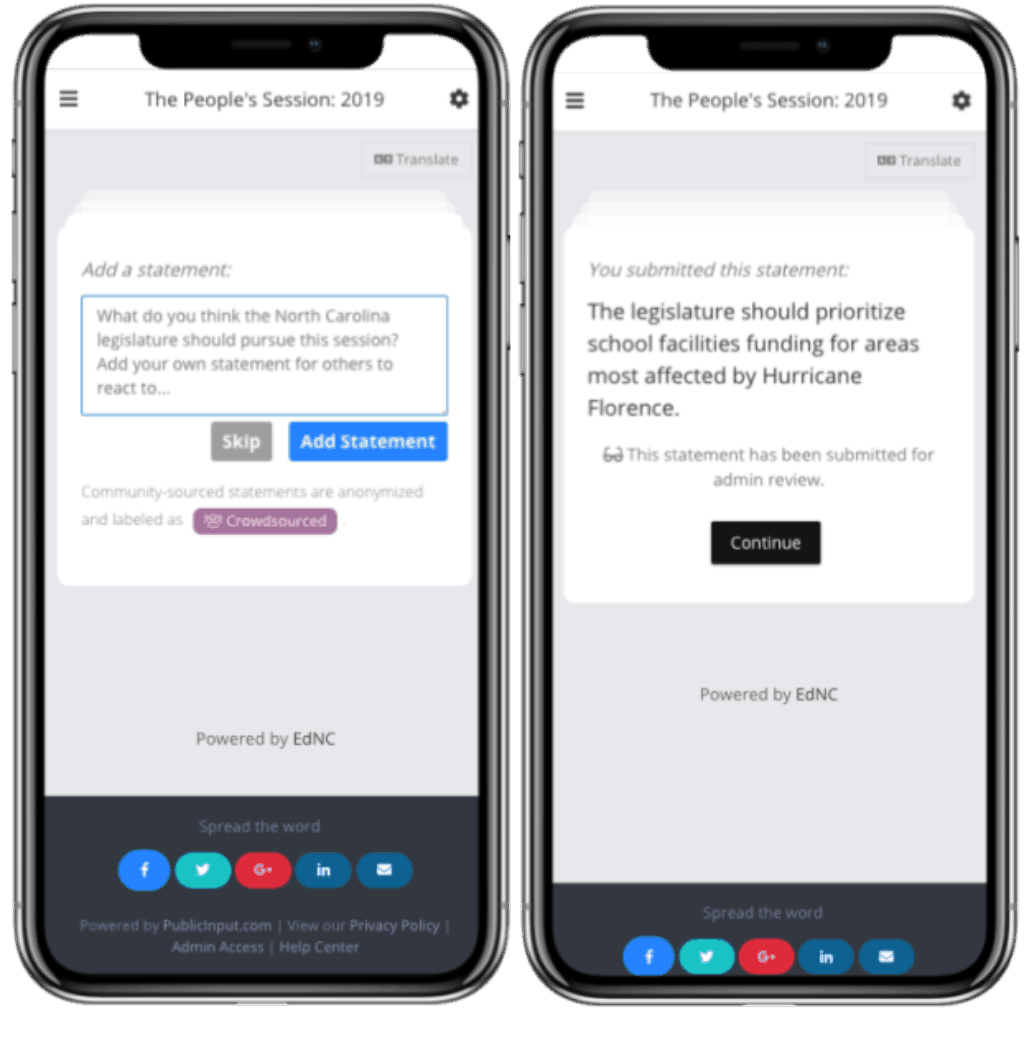
After answering 10 statements, participants also had the opportunity to view the results of the statements they had previously answered.
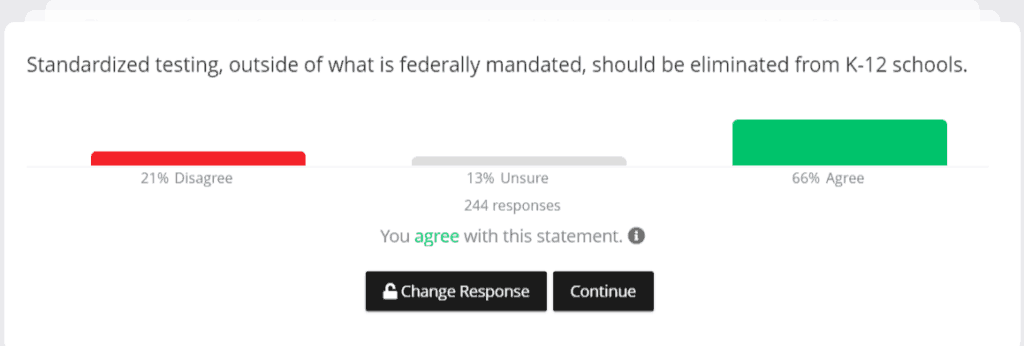
Who participated?
Over 16 days, 1,058 people participated in the People’s Session. On average, participants voted on 42 statements each, resulting in a total of 44,611 votes. One hundred and one participants submitted 196 statements on issues ranging from school performance grades to school safety to teacher pay. One participant submitted 12 statements, while others only submitted one.
As the moderators, we rejected roughly two-thirds of the statements, usually in order to weed out duplicates and occasionally because they did not include a policy statement, were inappropriate, or were too vague to be included. Of the 196 comments submitted, 73 were left out for being duplicates of existing statements. This was expected, as users were able to submit a statement after seeing only 10 of the statements in the project. Twenty-nine statements were left out for not including a policy issue or statement, while another 26 statements were left out for being too niche or too vague for a statewide conversation.
In the end, the project included 103 statements, 35 of which were originally included in the project and 68 of which were added by participants.
Most of our participants joined the People’s Session after receiving an email inviting them to do so. Over the course of two weeks, our team sent 181,000 emails to the roughly 90,000 parents, teachers, students, and other community members on our email lists. As shown in the graphs below, participants were disproportionately white and highly educated, both of which reflect the demographics of North Carolina educators.
Although we also publicized the event on social networks, we did not attempt to ensure a randomized participant pool. Therefore, we cannot define the margin of error for the responses or extrapolate the results to the broader population of North Carolina.
In order to better understand who was participating in the People’s Session while still encouraging a high response rate, demographic questions were optional and listed below the People’s Session questions on the page. Of the 1,058 total participants, 362 submitted demographic information.
Note: An in-depth report, that will include a breakdown of results for all statements included in the People’s Session, is forthcoming.


